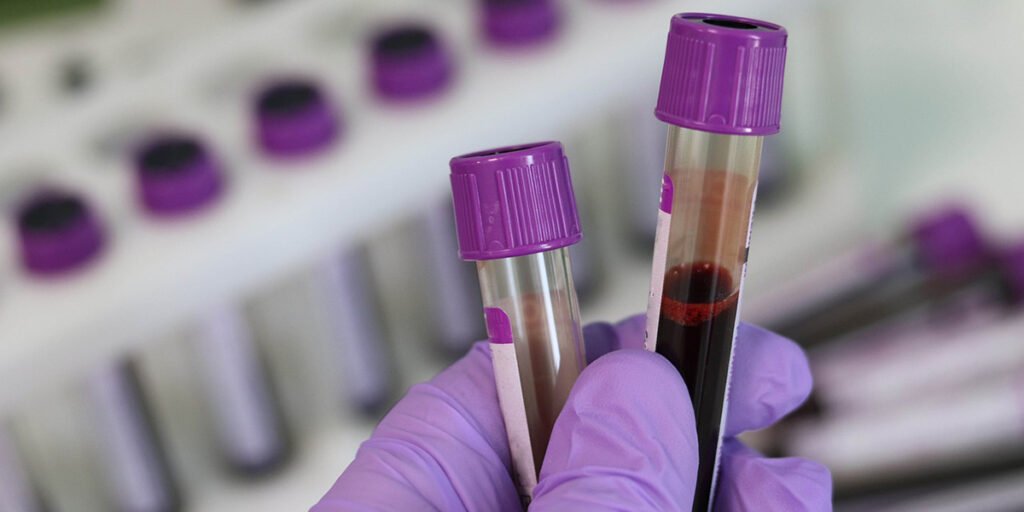
What is Iron Deficiency Anemia?
Iron deficiency anemia is a common anemia, the main cause is the lack of enough healthy red blood cells in the blood. The function of red blood cells is to carry oxygen to body tissues.
As the name tells itself, iron deficiency anemia is a lack of iron. When iron is insufficient, the body cannot produce enough oxygen to carry hemoglobin, which makes people short of breath and feel tired. Generally speaking, iron deficiency anemia can be improved by supplementing iron. Sometimes, other tests are needed if your doctor suspects internal bleeding.
How common is iron deficiency anemia?
Iron deficiency anemia is very common, especially in women and people whose diets don’t get enough iron. Iron deficiency anemia can be improved by reducing risk factors, please discuss with your physician for further information.
Symptoms of iron deficiency anemia
The following are common symptoms of iron deficiency anemia:
-
- Extremely tired
- Weak
- Pale skin
- Chest pain, fast heartbeat, shortness of breath
- Dizziness, headache, lightheadedness
- Cold hands and feet
- Tongue pain or inflammation
- Brittle nails
- Unusual cravings for non nutritious foods, such as ice or starches
- Loss of appetite, more pronounced in infants and children
At first, iron deficiency anemia may be mild or even non-existent. However, as the anemia becomes more severe, the symptoms become more pronounced. The above is not an exhaustive list, please consult your physician if you have any concerns.
When should I see a doctor?
See your doctor if you or your child develops symptoms of iron deficiency anemia. Iron deficiency anemia cannot be self-diagnosed or self-treated, so talk to your doctor first before taking iron supplements on your own. Excess iron can be harmful to the body and can damage the liver and lead to other complications.
Causes of Iron Deficiency Anemia
Iron deficiency anemia occurs when the body does not have enough iron to produce hemoglobin. Hemoglobin is the part of red blood cells that gives blood its red color and helps carry oxygen throughout the body. If the body does not take in enough iron or loses too much, it cannot produce enough hemoglobin, eventually causing iron deficiency anemia.
The following are causes of iron deficiency anemia:
-
- Blood loss
The red blood cells in the blood contain iron. If the blood is lost, the iron will also be lost. Women with heavy menstrual bleeding are at risk of iron deficiency anemia due to excessive blood loss during menstruation. Chronic blood loss in the body, such as from a peptic ulcer, hiatal hernia, colon polyp, or colorectal cancer, can also cause iron deficiency anemia. Regular use of over-the-counter pain relievers, especially aspirin, may cause gastrointestinal bleeding.
- Blood loss
-
- Dietary Iron Deficiency
The body gets iron from the diet regularly. If it does not get enough iron, the body will become deficient in iron over time. Iron-rich foods include meat, eggs, green leafy vegetables, and iron-fortified foods. To grow well, infants and young children also need iron in their diet.
- Dietary Iron Deficiency
-
- Unable to absorb iron
Iron absorption is located in the small intestine. If you suffer from intestinal diseases, such as celiac disease, or part of the small intestine is removed or bypassed due to surgery, it may affect food digestion and nutrient absorption, leading to iron deficiency anemia.
- Unable to absorb iron
-
- Pregnancy is prone to iron deficiency
Many pregnant women are prone to iron deficiency anemia if they do not supplement enough iron, because the body’s blood flow increases and the growing fetus also needs hemoglobin.
- Pregnancy is prone to iron deficiency
Risk Factors for Iron Deficiency Anemia
Many factors can increase the risk of iron deficiency anemia, such as:
-
- Women’s menstrual period
Because women lose a lot of blood during their menstrual period, women are generally at a higher risk of developing iron deficiency anemia.
-
- Infants and children
Infants who do not get enough iron from breast milk or formula can develop iron deficiency, especially those who are underweight or born prematurely. For children, extra iron is needed for growth. If children do not consume a healthy and varied diet, they may be at risk of anemia.
- Infants and children
-
- Unbalanced diet
Vegetarians (no meat) are more likely to develop iron deficiency anemia if they do not consume other iron-rich foods.
- Unbalanced diet
-
- Frequent blood donors
People who donate blood regularly have a higher risk of iron deficiency anemia because donating blood takes away iron from the body. Low hemoglobin caused by blood donation can be alleviated by consuming iron-rich foods. If you cannot donate blood due to low hemoglobin, please consult your doctor whether you should pay special attention to this situation.
- Frequent blood donors
Diagnosis and treatment of iron deficiency anemia
The following information is not a medical diagnosis. For further information, please consult your physician at any time.
To diagnose iron deficiency anemia, doctors may do the following tests:
-
- Red blood cell size and color
People with iron deficiency anemia have smaller and lighter red blood cells than normal.
- Red blood cell size and color
-
- Percentage of red blood cells in blood volume
The normal value is 34.9%-44.5% for adult women and 38.8%-50% for adult men. The above values may change due to age.
- Percentage of red blood cells in blood volume
-
- Lower hemoglobin levels indicate anemia
The normal range is 13.5-17.5 grams per deciliter (g/dL) for men and 12-15.5 for women. Normal values in children depend on age and sex.
- Lower hemoglobin levels indicate anemia
-
- The value of ferritin
Ferritin can help store iron in the body. If the value is low, it means that the iron storage in the body is low.
- The value of ferritin
If blood tests reveal iron deficiency anemia, your doctor may order other tests to look for potential causes, such as:

Physicians usually use an endoscope to check for hiatal hernias, ulcers, or stomach bleeding. An endoscope is a long, thin tube with a lens inserted down the throat into the stomach (esophagus) to find the source of the bleeding.
To find the site of lower GI bleeding, your doctor may recommend a colonoscopy. A colonoscope is a thin tube with a lens inserted into the rectum and then into the colon, usually under anesthesia. A colonoscopy allows the doctor to view part or all of the inside of the rectum and colon to help find areas of internal bleeding.
Women may also have an Ultrasound Pelvis to find the cause of heavy menstrual bleeding, such as uterine fibroids.
Your doctor may order these or other tests after trying iron therapy
How is iron deficiency anemia diagnosed?
To treat iron deficiency anemia, your doctor may recommend iron supplements. Physicians also treat the underlying cause of the iron deficiency, if necessary. Also, your doctor may recommend that you supplement with over-the-counter iron lozenges, and your doctor will tell you how much to take. Iron supplements may also come in liquid form, which is easier for babies and children to take. To increase the body’s chances of absorbing iron supplements, the following are possible suggestions:
-
- Take on an empty stomach
If possible, try to take iron supplements on an empty stomach. However, since iron supplements may cause stomach upset, they may need to be taken with food.
- Take on an empty stomach
-
- Do not take antacids at the same time:
Medications that relieve heartburn immediately may interfere with iron absorption, so take iron 2 or 4 hours before taking antacids.
- Do not take antacids at the same time:
-
- Take vitamin C at the same time
Vitamin C can help iron absorption, and your doctor may recommend that you take iron supplements with orange juice or vitamin C.
- Take vitamin C at the same time
-
- Concomitantly taking stool softeners
Because iron supplements can cause constipation, your doctor may recommend using a stool softener. In addition, iron may darken the color of stool, a harmless side effect.
- Concomitantly taking stool softeners
Iron deficiency anemia does not go away overnight and may require continued iron supplements for several months or longer. Usually, after about a week of treatment, you will feel an improvement. Ask your doctor when to have blood drawn to check iron levels. You may need to continue taking iron supplements for 1 year or more to keep your iron levels in check.
If taking iron supplements does not increase iron levels in the blood, the anemia may be due to bleeding or absorption problems. Depending on the cause, the following are possible treatments:
-
- Taking medicines, such as oral contraceptives, to reduce menstrual bleeding
- Antibiotics or other medicines for peptic ulcers
- Surgery to remove bleeding polyps, tumors, or fibroids
- If iron-deficiency anemia is severe, you may need iron or blood transfusions through an IV to give your body fast access to iron and hemoglobin.
Life adjustment and home therapy for iron deficiency anemia
The following home remedies and life adjustments may help iron deficiency anemia:
1. Choose iron-rich foods:
-
- Red meat, pork
- Seafood
- Beans
- Dark vegetables such as: spinach
- Dried fruit, such as: raisins, dried apricots
- Iron-fortified cereal, bread, or pasta
- Pea
The body absorbs the most iron from meat compared to other sources. If you don’t eat meat, you may need to increase your intake of iron-rich plant foods to give your body the same amount of iron as a meat eater.
2. Choose foods that contain vitamin C:
-
- Broccoli
- Grapefruit
- Kiwi fruit
- Green leafy vegetables
- Melon
- Tangerine
- Black pepper
- Strawberry
- Tomato
3. Babies drink breast milk or iron-fortified formula
In order to prevent iron-deficiency anemia in infants, babies under 1 year old should be fed breast milk or iron-fortified formula. Cow’s milk is not a suitable source of iron for infants and is not recommended for infants under 1 year of age. After 6 months of age, you can start feeding your baby iron-fortified cereal or pureed meat to increase your iron intake. After the age of 1, please ensure that the child drinks no more than 591 milliliters (ml) of milk per day. Excessive milk usually crowds out the intake of other foods, including iron-rich foods.
Best Books for Anemia – Just Click to Buy
Anemia
The book is written in an easy-to-read and understanding tone and is full of excellent advice and solutions to your issues. Controversies from the standpoint of subspecialists specialized in addressing key causes of anemia within their respective fields are also given. Easy-to-reference and published by professionals in each clinical scenario, Management of Anemia is the starting point…
Anemia Diet Cusine Cookbook
Anemia is a condition where there’s a decrease in the number of healthy red blood cells, or RBCs, in the body. So, iron deficiency anemia means anemia caused by a deficiency in iron. Iron deficiency anemia is also the most common type of anemia worldwide. Anemia (also known as Iron-poor blood, Low blood, Tired blood) Anemia is a condition in which your blood has a lower-than-…
Iron Deficiency Anemia Cookbook
Iron is an incredibly vital mineral for your overall health. Not only is it crucial for the efficient transportation of oxygen, it is also required for most biochemical reactions in your body. In as much as iron is essential for everyone, people who lead a very active lifestyle such as athletes have higher needs as the rate of red blood cells destruction which is directly correlated with activity is…
Test Kit for Your Blood – Just Click to Buy
System Accu – Answer isaw Blood Multi-monitoring System
- Cholesterol Meter Glucose Meter Uric Acid Meter Hemoglobin Meter 4 in 1 function
- Supplied with starter packs of each test strip
- Low cost refil test strips available just search “Accu-Answer isaw”
- Great value 4 in 1 System Fully CE certified for professional and self testing use
Komwell Blood Cholesterol, Blood Glucose, Hemoglobin and Blood Uric Acid Test Kit
- Cholesterol Meter Glucose Meter Uric Acid Meter Hemoglobin Meter 4 in 1 function
- Supplied with starter packs of each test strips,Includes: 10 x glucose test
cerascreen® Ferritin Test – Determine Your Ferritin Value Quick & Easy from Home
DID YOU KNOW? – Iron deficiency is the most common nutrient deficiency in the world. cerascreen developed the Ferritin Test for you to easily measure your iron values according to the gold standard and to remedy your iron deficiency.


















